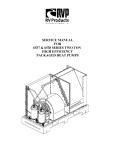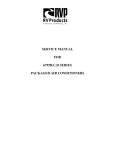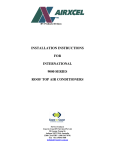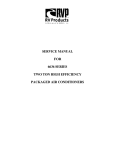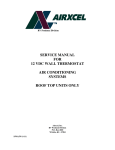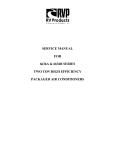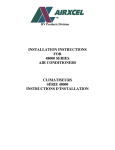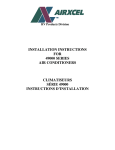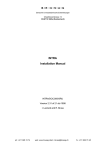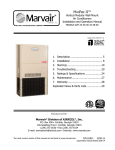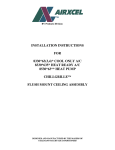Download RV Products 6536 SERIES Unit installation
Transcript
INSTALLATION INSTRUCTIONS FOR 6536 SERIES TWO TON PACKAGED HEAT PUMP TABLE OF CONTENTS 1. 2. 3. 4. 5. 6. 7. 8. 9. 10. 11. Warnings . . . . . . . . . . . . . . . . . . . . . . . . . . . . . . . . . . . . . . . . . . . . . . . . . . . . . . . . . . . . . . . . . . . . . . . . . . 2 Component Match-Up . . . . . . . . . . . . . . . . . . . . . . . . . . . . . . . . . . . . . . . . . . . . . . . . . . . . . . . . . . . . . . . . 2 Unit Depiction Figures . . . . . . . . . . . . . . . . . . . . . . . . . . . . . . . . . . . . . . . . . . . . . . . . . . . . . . . . . . . . . . . 3 Blower Performance Data . . . . . . . . . . . . . . . . . . . . . . . . . . . . . . . . . . . . . . . . . . . . . . . . . . . . . . . . . . . . 5 General Information . . . . . . . . . . . . . . . . . . . . . . . . . . . . . . . . . . . . . . . . . . . . . . . . . . . . . . . . . . . . . . . . . 5 Unit Installation . . . . . . . . . . . . . . . . . . . . . . . . . . . . . . . . . . . . . . . . . . . . . . . . . . . . . . . . . . . . . . . . . . . . . 5 Duct Mounting and Configuration . . . . . . . . . . . . . . . . . . . . . . . . . . . . . . . . . . . . . . . . . . . . . . . . . . . . . . 6 Duct and Register Specifications . . . . . . . . . . . . . . . . . . . . . . . . . . . . . . . . . . . . . . . . . . . . . . . . . . . . . . 7 115 VAC Electrical Wiring . . . . . . . . . . . . . . . . . . . . . . . . . . . . . . . . . . . . . . . . . . . . . . . . . . . . . . . . . . . . 8 Thermostat and 12 VDC Wiring . . . . . . . . . . . . . . . . . . . . . . . . . . . . . . . . . . . . . . . . . . . . . . . . . . . . . . . . 9 Checkout . . . . . . . . . . . . . . . . . . . . . . . . . . . . . . . . . . . . . . . . . . . . . . . . . . . . . . . . . . . . . . . . . . . . . . . . . 11 1. WARNINGS IMPORTANT NOTICE WARNING - SHOCK HAZARD These instructions are for the use of qualified individuals specially trained and experienced in installation of this type equipment and related system components. To prevent the possibility of severe personal injury or equipment damage due to electrical shock, always be sure the electrical power source to the appliance is disconnected. Installation and service personnel are required by some states to be licensed. PERSONS NOT QUALIFIED SHALL NOT INSTALL NOR SERVICE THIS EQUIPMENT. CAREFULLY FOLLOW ALL INSTRUCTIONS AND WARNINGS IN THIS BOOKLET TO AVOID DAMAGE TO THE EQUIPMENT, PERSONAL INJURY OR FIRE. NOTE WARNING The words “Shall” or “Must” indicate a requirement which is essential to satisfactory and safe product performance. Improper installation may damage equipment, can create a hazard and will void the warranty. The words “Should” or “May” indicate a recommendation or advice which is not essential and not required but which may be useful or helpful. The use of components not tested in combination with these units will void the warranty, may make the equipment in violation of state codes, may create a hazard and may ruin the equipment. WARNING DO NOT PERFORM A DIELECTRIC STRENGTH TEST (HYPOT) ON 6536 SERIES HEAT PUMPS. DAMAGE TO PRINTED CIRCUIT BOARD MAY RESULT. 2. COMPONENT MATCH-UP 1. 6536 Series Two Ton Packaged Heat Pump. (Reference specifications for model number breakdown and identification.) 2. 6536-3451 or 6536-3351 Electronic 12 VDC Wall Mounted Thermostat. This thermostat is pre-wired to two electrical connectors. Both the thermostat supply and control wiring can be quickly attached (plugged in) to the thermostat. 3. 2 6795C4351 35' thermostat cable with connector plugs for termination at both the heat pump and electronic thermostat. 3. UNIT DEPICTION FIGURES Side Discharge Configuration Top Discharge Configuration FIGURE 1 3 Side Discharge Configuration Top Discharge Configuration FIGURE 4 4 4. TWO TON PACKAGED HEAT PUMP BLOWER PERFORMANCE DATA TEST CONDITION: 115 VAC, 60 HZ, 1 PHASE, DRY COIL CHART 1 5. GENERAL INFORMATION The 6536 heat pump is intended only for installation by RV manufacturers. The unit is for “off the roof” installations and will usually be installed under the floor of the vehicle. It is understood that the vehicle manufacturer has provided an installation area which allows for floor cutouts and unit mounting without cutting vital frame members or electrical wiring and that structural members in the installation area will not create restrictions by passing through airways required by the heat pump. air filter and filter retainer are also supplied by the vehicle manufacturer. Conditioned air is delivered from the heat pump to the interior of the vehicle through ducting that is supplied and installed by the vehicle manufacturer. The system return air duct, return Avoid sliding the heat pump without the shipping block being attached. The indoor coil condensate drain fitting extends slightly below the pan and will be damaged if not protected. The heat pump is powered by two separate 115 volt 20 AMP electrical services. The heat pump is controlled by a 12 VDC electronic wall mounted thermostat. The vehicle manufacturer must provide the power source for the thermostat. 6. UNIT INSTALLATION CONDENSING AIR FLOW The heat pump must be installed so that the side that houses both the outdoor coil and the electrical box, faces outboard. The heat pump is installed this way so that: To provide adequate outdoor air flow, the installer must adhere to the following guidelines: 1) the outdoor coil air flow will be drawn in from the outdoors through the side of the vehicle; and 1) Install the heat pump so that the outdoor coil faces the outer skin of the vehicle; and 2) the heat pump can be serviced electrically. 2) The outdoor air path to the coil should be as direct and non-restrictive as possible. RV Products 5 recommends placing the exterior air flow grille into the side of the vehicle, directly in front of the outdoor coil. The installer must provide the exterior air opening and/or grille. In order to improve installation time and reduce down time when servicing, RV Products recommends using drawer slides for mounting the heat pump. 3) Any decorative grille or louver used as an opening for outdoor coil air flow must have 354 square inches of free area. 4) Do not block or restrict the discharge air opening (located in the bottom of the heat pump) with any flooring or bracing. This unit must be supported from below by angle iron, channels or RV frame members. These supports must be located under the air conditioner and kept within the areas shown (cross-hatched) in Figure 2. Support must be provided in the areas indicated to both secure the compressors and balance the system. Adding support outside of the indicated area may interfere with either the condenser air outlet or the condensate drain. 5) The air that is being used by the outdoor coil cannot be drawn from the underside of the vehicle. Seal or baffle the sides and bottom edge of the heat pump to prevent the recirculation of air from underneath the vehicle. Recirculation of air across the outdoor coil will decrease both system performance and equipment life. When suspending the unit from flooring or frame members, a minimum of four threaded rods are required. Minimum rod diameter is 5/16". The support rods and hardware must be plated or equivalently protected against corrosion. All threaded fasteners should be provided with lock washers, “locktite”, “double-nutted”, or equivalently protected from loosening after installation. 6) Do not install any other heat generating appliance in the same cavity as the heat pump. Additional heat in this cavity will decrease system performance and equipment life. Overall package dimensions are shown in Figure 1. RV Products requires that a minimum of 4 additional inches be allowed at the wiring box end of the heat pump to allow for the installation of both low and high voltage wiring. After mounting heat pump, install the barbed end of the drain tube assembly (shipped in wirebox) into the drain pan opening in the bottom of the unit. Ensure that neither the vehicle engine exhaust, onboard generator engine exhaust or water heater vent exhaust are pulled into the outdoor coil air flow. These hot gases will both: (a) increase system temperature reducing performance and equipment life; and (b) the collection of these gases chemical byproducts will begin the chemical degradation of the surfaces they collect on. Upon completion of the installation, verify that the heat pump has a minimum clearance of 14" from the basepan to ground level. 7) Heat pump condensation may at times splash out of the drain pan and drain from the unit corners. Therefore, do not mount the unit above areas which might be damaged by exposure to moisture. 7. DUCT MOUNTING AND CONFIGURATION This system is designed for the top of the heat pump to seal to the bottom of the flooring in the vehicle. The ducting for the unit attaches and seals to the top and side. Cut-outs in the flooring provide passage for return air. DANGER - SHOCK HAZARD Do not drill any openings into this heatpump. Drilling new openings and inserting screws may damage either the refrigeration circuit or electrical wiring causing possible equipment damage, personal injury or death. The 6536 series heat pump is available in two cabinet configurations; top discharge and side discharge (See Figure 1). Both configurations have top and side return air openings. Ducting to both return air openings is preferred, but using one opening is adequate. IMPORTANT Regardless of installation configuration, ensure that all duct connections are air tight. Loose or leaking connections can reduce system performance and allow gases, odors and dirt to be drawn in from outside the vehicle. Under no circumstances should any of the openings or associated ducting be allowed to have a misaligned or smaller inner perimeter than any heat pump opening. 6 8. DUCT AND REGISTER SPECIFICATIONS GENERAL INFORMATION Any ducting exposed to heat sources must be further insulated to prevent significant performance degradation due to heat gain. An example of an area capable of creating significant heat gain is the roof area which can sometimes experience temperatures of 160 degrees or more when exposed to direct sunlight. For ducting in or near the ceiling, it is impossible to provide “too much” thermal insulation. All supply air ducts, registers, return air ducts, return air filters and filter retainers must be supplied by the installer or vehicle manufacturer. Any ducting (supply or return) exposed to a heat source or outdoor environment must be sealed and insulated to prevent heat gain and decreased system performance. GUIDELINES FOR SUPPLY AIR REGISTERS Supplied with these instructions is a blower performance table, See Chart 1. The blower performance table is provided so that the installer has a method for testing and determining duct efficiency. The blower performance table shows the resulting evaporator blower air delivery and amperage draw when operating against various external static pressures. Total free area provided by the supply air registers must equal a minimum of 72 square inches. Free area is the size of the opening(s) that remain in a grille or louvered panel after restrictions (the louvers) are subtracted. Most metal and plastic grilles average 30% to 60% open. That is the actual “free area” for the grille will be 30% to 60% of the total opening area. By measuring the air distribution system operating pressure, the installer can determine the amount of air that the system is delivering. The design rated air flow on high fan speed in 600 SCFM (standard cubic feet per minute), with approximately .5 inches of static pressure in the ducting. Increased system performance and quicker vehicle cool down can be achieved by reducing the duct system static pressure. An increase in duct static pressure reduces air flow, system performance and vehicle cool down time. GUIDELINES FOR RETURN AIR DUCTING AND FILTERS All return air must be filtered. A 1-inch thick, 10" x 20" disposable fiberglass filter is recommended. A washable filter is acceptable if supported by a mesh or grille to prevent collapse. Should the return air filter and filter retainer be located in the floor, a traffic duty grille will be required. The return air filter should be located in an area where: RV Products strongly recommends that all air distribution systems be tested by the vehicle manufacturer in a floor mockup prior to installation in the vehicle. In doing so, the vehicle manufacturer can insure that air volume, distribution and noise levels are optimized. GUIDELINES FOR SUPPLY AIR DUCTING 1) drapes or bed sheets cannot block the opening; 2) the consumer can gain easy access for servicing. This system is designed to operate without return air ducting. However, the fabrication and use of return air ducting is permissible. The unit must have at least 200 square inches of filtered return air register or registers if ducting is used. Total free area inside the supply duct can be no less than 48 square inches. Ducting with more free area than 48 square inches will improve system performance and vehicle cool down time. When a return air duct is utilized, it is recommended that: To decrease restriction and increase air flow, the ducting should make as few bends and turns as possible. When corners or turns are required, it is recommended that these turns be radiused and as gradual as possible. The supply duct, unless made of an insulating material, must be insulated to prevent condensation from collecting on its exterior. Moisture condensation within the ceiling or wall cavity can damage insulation, stain vehicle interiors or create odors. 1/8", 3 pound density fiberglass or closed cell foam insulation has proven effective for this purpose. 1) the length of the duct be kept to an absolute minimum; 2) the inner perimeter of the duct be kept as large as possible. Return air ducting will contribute to the overall pressure and air flow loss of the system. Should the addition of return air ducting reduce air flow below acceptable levels, then either: 1) 7 the supply air duct inner perimeter will need to be enlarged; 2) the supply air registers will need to be added; 3) the return air duct inner perimeter will need to be enlarged; 4) the return air duct will need to be shortened; 5) all of the above. It is strongly recommended that all air distribution systems be tested in a floor mock-up prior to installation in the vehicle. In doing so, the vehicle manufacturer can ensure that air volume, distribution and noise levels can be determined. Any ducting exposed to the outdoor environment must be sealed and insulated to prevent heat transfer and decreased system performance. 9. 115 VAC ELECTRICAL WIRING 1. WARNING - SHOCK HAZARD To prevent the possibility of severe personal injury or equipment damage due to electrical shock, always be sure the electrical power is disconnected or off before beginning installation. 2. This heat pump contains a dual compressor refrigeration system. The two compressors can either cycle independently or operate in tandem. Each compressor is connected to a separate refrigeration circuit and a separate electrical circuit. The first compressor and refrigeration circuit to operate when the thermostat is calling for cooling is referred to as "1st Stage Cooling". The second compressor and refrigeration circuit to operate is referred to as "2nd Stage Cooling". 3. Both first and second stage cooling systems require power from separate 115 volt electrical circuits. The two separate circuits connect to a high voltage terminal board in the air conditioner electrical box. The high voltage terminal board is specifically labeled for the two separate electrical connections. The markings are for "CIRCUIT 1" and "CIRCUIT 2". 1) Connect each circuit's black (115V to GND) power lead to the "BLACK" high voltage lug; 2) Connect each circuit's white (-0-V to GND) power lead to the "WHITE" high voltage lug; 3) Connect each circuit's green or bare copper ground wire to the grounding lugs located in the electrical box. The high voltage grounding lugs for circuit 1 and 2 are located just left of the high voltage terminal board. High Voltage Wiring Specifications A) U.L. approval requires the power supply to be copper conductors only with a minimum size of #12 AWG. B) To prevent voltage drops of greater than 10% during starting loads, adhere to the following guideline: For lengths greater than 50', use #10 AWG. 4. "CIRCUIT 1" connections supply power for the 1st stage cooling unit. "CIRCUIT 2" connections supply power for the 2nd stage cooling unit. For circuit protection, adhere to the following guidelines: Time Delay Fuse - Maximum 20 AMP Circuit Breakers (H.A.C.R. Type) - Maximum 20 AMP (C.S.A.) - Maximum 20 AMP On the terminal board, the termination point for both circuit 1 and 2 is equipped with two highvoltage wiring lugs. Each lug is identified with either the word “BLACK” or “WHITE”. 5. DANGER - SHOCK HAZARD High Voltage Routing Specifications When routing the high voltage supply wiring for both circuit 1 and 2, the following guidelines must be followed: To prevent electrical shock due to miswiring, adhere to the following procedure: A) 8 Route all wiring per applicable local and national electrical codes. B) C) Each circuit high voltage wiring must be routed through a separate opening in the outer cabinet of the wiring box. These openings are referred to as the "power wire entries". See Figure 1. RV Products provides these two openings, each opening is a 7/8" diameter opening. STRAIN RELIEF CONNECTORS OR CLAMPS SHOULD BE USED. Each circuit wiring must be secured at the "power wire entry" by a U.L. listed "Rain Tight" or equivalent electrical conduit fitting. The fitting must be supplied by the installer or vehicle manufacturer. D) The installer must form a drip loop in the high voltage wiring routed between the “Rain Tight” electrical fitting and the high voltage terminal board wiring lugs. Do not allow excess wiring to contact electrical terminals, sharp screw ends or edging that can cut or damage the wiring insulation. E) After connecting the ground wire to the grounding lug, verify that the ground wire (which in some instances will be bare copper) cannot come into contact with any high voltage terminal. IN NO CASE SHOULD CLAMPING OR PINCHING ACTION BE APPLIED TO THE INDIVIDUAL SUPPLY LEADS (NEUTRAL AND “HOT” WIRES). DANGER WHEN USING NON-METALLIC SHEATH SUPPLY CABLES (ROMEX, ETC.), STRIP SHEATH BACK TO EXPOSE 4-6 INCHES OF THE SUPPLY LEADS. STRIP THE INDIVIDUAL WIRE LEAD ENDS FOR WIRE CONNECTION (ABOUT 3/4" BARE WIRE). INSERT THE SUPPLY WIRES INTO THE ELECTRICAL CONNECTOR CLAMP. SHEATH MUST PROTRUDE PAST CLAMP BUSHING INSIDE THE BOX. MAKE SURE SHEATH CABLE IS CENTERED IN CLAMP BEFORE TIGHTENING IT. DO NOT OVERTIGHTEN!! THIS COULD RESULT IN PINCHING THROUGH THE PLASTIC WIRE INSULATION AND CAUSE SHORTING OR “HOT” WIRES TO GROUND (SHOCK HAZARD). THE CLAMP IS INTENDED FOR STRAIN RELIEF OF THE WIRES, SLIGHT PRESSURE IS USUALLY SUFFICIENT TO ACCOMPLISH THIS. DANGER - SHOCK HAZARD TO PREVENT THE POSSIBILITY OF SHOCK INJURY FROM APPLIANCE OPERATION: THE WHITE WIRE MUST BE CONNECTED TO NEUTRAL IN THE SERVICE BOX ENTRANCE AND THE MECHANICAL GROUND MUST BE CONNECTED TO A GROUNDING LUG EITHER IN THE SERVICE BOX OR THE MOTOR GENERATOR COMPARTMENT. IF OTHER THAN NON-METALLIC CABLES ARE USED FOR SUPPLY CONDUCTORS, APPROPRIATE 10. THERMOSTAT AND 12 VDC WIRING THERMOSTAT OPERATING AND WIRING REQUIREMENTS The thermostat can control one stage heating (user selectable between fuel burning appliances or heat pump) and two stages of cooling. The 6536 heat pump is designed to be operated from an RV Products electronic wall mounted thermostat. See Component Match-Up Section for thermostat part number and description. The thermostat is designed to operate 12 VDC controlled heating and air conditioning systems. The thermostat must be operated from a 12 VDC power source. Maximum thermostat output for any load (including the furnace control wire) is one amp. The thermostat is equipped with a replaceable fast-acting 2 amp fuse located on the base of the thermostat. The fuse is designed to open if the furnace is mis-wired or there is a short 9 in the system. Before replacing fuse, the cause of the failure must be located and corrected. IMPORTANT When using wire nuts to complete electrical connections, always apply a U.L. approved electricians tape and secure the wire nuts in a workmanlike manner. IMPORTANT Current draw in excess of one amp or shorting any thermostat wires can cause permanent thermostat failure. At the thermostat, the connection is completed with a square 9 pin receptacle that slides together and snap-locks in place. When making this connection: The installer must provide the power used to operate both the thermostat and its control circuits. This power source must provide one amp of continuous current at 12 VDC. The thermostat is pre-wired at RV Products with two quick connect electrical receptacles. There is one 9 pin receptacle carrying the control wires required to operate the heat pump, and a 3 pin receptacle carrying the two power supply leads and the one furnace control lead. 1) verify that the connectors are properly aligned. 2) do not use excessive force when joining the connectors. 3) verify that the connectors have snapped together on both sides. The thermostat umbilical attaches to the unit with a rain-tight fitting. To install, remove the ring-nut from the rain-tight fitting and insert the wire end and fitting into the hole in the wirebox side. The ring-nut will now slide over the wire end and reinstall onto the rain-tight fitting threads. Tighten securely. The wire end plugs into the receptacle on the wirebox printed circuit board. Insure that the plug “snap-locks” into the receptacle. The thermostat 9 pin receptacle mates with a receptacle on one end of the RV Products 35' pre-wired thermostat harness. See Component Match-Up Section for harness part number and description. The thermostat harness does not include the wiring for the 3-pin plug. Should the installer desire a total plug in system, then the mate and pins for this connection must be purchased separately. Both the receptacle and the pins are manufactured by AMP (Aircraft Marine Products, Inc., Harrisburg, PA). In most cases the parts can be obtained through a local supply house. Routing of the thermostat wiring harness must comply with all local and national electrical codes. Collect any excess thermostat harness in the air conditioner mounting compartment. Coiling the excess harness into 3" diameter circles or larger is acceptable. THERMOSTAT MOUNTING Follow the instructions packed with the thermostat to select a location for thermostat mounting. Pay particular attention to choose a location which is not isolated from air currents and not subject to direct discharge from a cold air register. The AMP part numbers are: 1) 2) 3 pin male receptacle #7-480700-0 Female pin (for male receptacle) #350218-1 CHART 2 Should the installer desire to hard wire this connection rather than purchasing the receptacle, the three pin connector can be cut from the wire ends, the wires stripped and spliced to complete the required connections. For further wire identification and function, reference Chart 2. 10 11. CHECKOUT 1. Before engaging power to any system, ensure the following: Keep in mind that the wall thermostat provides a 3 minute delay between off and on cycles. A 2.5 minute delay begins both as soon as the compressor cycles off, and as soon as the thermostat becomes energized. After completion of the 2.5 minute delay, an additional 30 second delay will begin as soon as the thermostat demands cooling. A) All tools have been removed from the equipment. B) All wiring is attached, routed and properly secured. C) All panels (both mechanical and electrical) are in place. D) The thermostat system switch is placed into the “OFF” position. E) All co-workers have been warned that the equipment is being energized. 4. After complying with steps 1 through 3, engage power to all systems and begin check-out procedure. 2. System wiring may be checked by referring to the wiring diagram located on the back of the wiring box door. 5. Test each thermostat function such as fan modes, heat modes and cool modes to insure proper operation. 3. Before beginning the check-out procedure, thoroughly read the check-out instructions in either the thermostat installation instructions or in the owners manual provided with this product. There is also a 30 second delay between 1st and 2nd stage cooling. This is to prevent both compressors from starting simultaneously. To ensure that the thermostat calls for 1st and 2nd stage cooling, verify that the cool setpoint is well below actual indoor temperature. 11 RV Products A Division of Airxcel, Inc. P.O. Box 4020 Wichita, KS 67204 1976J255 (6-05) PP















